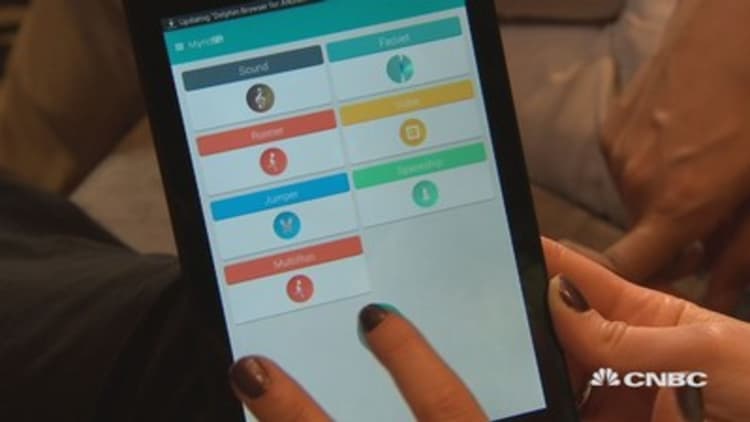Pac-Man, the ultimate '80s icon, is nearing middle age.
The arcade game turns 35 on Friday, and in the years since his debut, he has appeared on virtually every video game platform to hit shelves. But the the little yellow pellet muncher's reach has extended far beyond the gaming world.
He has fronted cereal boxes. He was on the cover of Time magazine. He has been the star of at least two cartoon shows (one in the '80s and one currently airing on Disney XD) . Buckner & Garcia's ode to the game- "Pac-Man Fever" hit #9 on the Billboard charts in 1981. And there are tens of thousands of tie-in products bearing his image.
Pac-Man, not surprisingly, is hands down the biggest product in the catalog of publisher Bandai Namco. It's so big, in fact, that the sole reason the company formed and launched its mobile division was to get the game onto cell phones and other handheld devices.
Read More Mobile gamemakers face a test of survival
Pinning down financials for the franchise isn't as easy as you might expect, though. The tens of millions of dollars that the game raised during its arcade heyday are impossible to definitively calculate (not surprising, given it was an all-cash business with lots of third-parties involved). And the character has appeared in so many different games and been merchandised in so many different ways that it's an accounting nightmare.
To lend some perspective, though, consider this: In the late 1990s, Twin Galaxies, a company that tracks video game world record scores, visited several used game auctions and counted how many times the average Pac-Man machine had been played. Multiplying those figures by the total number of machines that were manufactured, the organization believes the arcade game was played more than 10 billion times in the 20th century. That's $2.5 billion in quarters alone.
While Pac-Man might be the most recognizable character in the videogame world, he still has a few secrets that many people don't know. Here are some of the most interesting:
The point of the game was to attract girls
Gaming in the late 1970s was pretty much exclusively a men's club. Toru Iwatani, creator of the game, wanted to change this, creating something that could appeal to both women and families, he said.
"The reason I created Pac-Man was because we wanted to attract female gamers," he said at a panel during the 2011 Game Developers Conference. (Tweet This) "Back then, there were no home games. People had to go to the arcade center to play games. That was a playground for boys. It was dirty and smelly. So we wanted to include female players, so it would become cleaner and brighter."
It was almost a reality show
Pac-Man cartoons are nothing new. But in 2011, Merv Griffin Entertainment tried to adapt Pac-Man as a reality series. The show was envisioned as a "big, crazy wipeout-type event with a lot of energy." It hasn't been brought up again since, though, indicating that the producers couldn't find enough network support.
He was a YouTube gaming sensation long before it was cool
While many gamers today enjoy watching YouTube clips about their favorite titles, Pac-Man led the charge—kind of. In 2009, French prankster Rémi Gaillard dressed himself in a full-size Pac-Man costume, then had associates (dressed as ghosts, naturally) chase him through a supermarket, golf course and other locations. The clip has been viewed more than 50 million times.
Each ghost had specific orders
Despite what it might seem, the ghosts aren't all chasing Pac-Man. Iwatani intentionally avoided programming them with that purpose, since that would have resulted in Pac-Man zipping around the screen with four ghosts always right behind him. Only Blinky, the red ghost, doggedly pursues you throughout the game. Pinky, the pink ghost (naturally), simply wants to position itself at a point that's 32 pixels in front of Pac-Man's mouth. The blue ghost, Inky, is seeking to position itself at a similar fixed spot. And Clyde, the orange ghost, moves completely at random.
He's a family man
The most well-known of the many, many sequels Pac-Man inspired was Ms. Pac-Man, which extended Iwatani's goal of bringing girls to the arcade in a big way. Ms. Pac-Man was the first playable female character in any game, paving the way for characters like Lara Croft.
HR Departments hate the game
Five years ago, Google released a Pac-Man-inspired Google Doodle, letting people play a version of the game on their browsers. Site visitors played for nearly 500,000,000 hours—which, based on the average officer worker's salary, is estimated to have cost businesses roughly $122 million in lost productivity.


